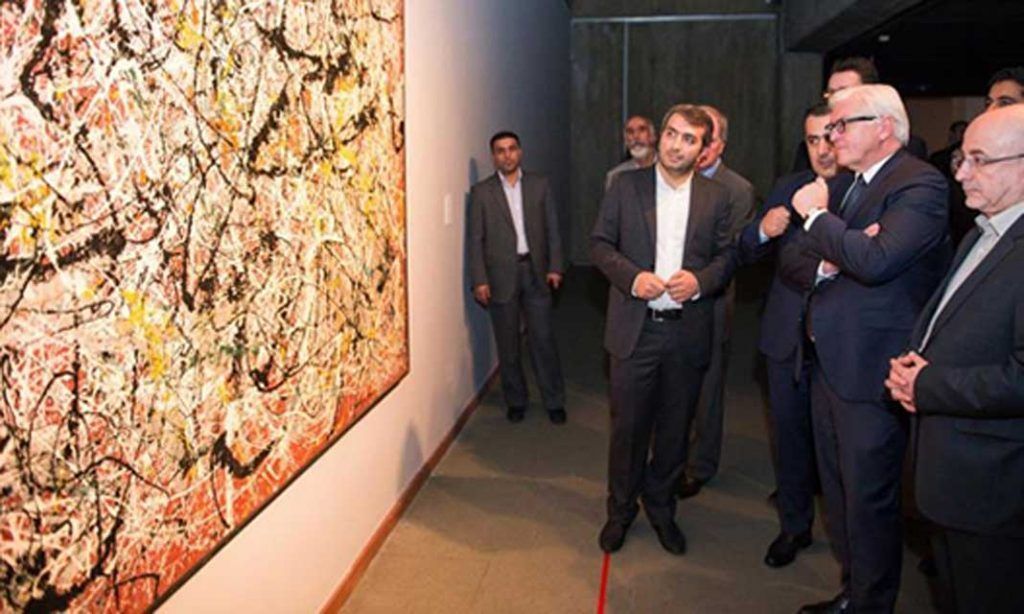December 07, 2016
by: Azadeh Karimi
On November 21, Seyyed Reza Salehi-Amiri, Iran’s Minister of Culture and Islamic Guidance, announced that the plan to exhibit a collection of artworks from Tehran Museum of Contemporary Art (TMoCA) at Berlin’s Gemälde Galerie had been postponed indefinitely.
According to The Guardian, the refusal of Iranian authorities to loan the artworks “has been met with disappointment and bewilderment in Berlin”. Hermann Parzinger, president of the Prussian Cultural Heritage Foundation (SPK), who had negotiated the loan stated: “We are ready and waiting to open the exhibition, but the paintings are still in Tehran.” He stressed that Iran needed to solve the issue soon. “We will not postpone this three, four, five times; there are limits.” he told the weekly Die Zeit.
Meanwhile, German Foreign Minister Frank-Walter Steinmeier, has said that his office is prepared to “be patient”. According to the daily Der Tagesspiegel, the head of the Neue Nationalgalerie, Joachim Jager, and cultural ambassadors from the foreign ministry will travel to Tehran in December to discuss the opening of the eagerly-awaited Berlin exhibition, even though ticket sales for the event have now been suspended.

A number of Iranian artists and organizations, including the Iran Painters Association oppose the exhibition citing a lack of transparency in the agreement between TMoCA and Berlin’s Gemälde Galerie. They petitioned the Majlis to pressure the Ministry of Culture to disclose the complete list of artworks that are to be shipped to Europe. There is also concern about the artworks being claimed or confiscated by a foreign government.
Ali Moradkhani, deputy culture minister, attended a meeting of the cultural committee of the Majlis to answer questions about the exhibition. He told MPs that the foreign ministers of Germany and Italy had written to their Iranian counterpart, Javad Zarif, guaranteeing the safety of the art collection.
The apprehension on the part of those opposing the exhibition stems from a previous incident when 500 works of art were transferred from the TMoCA to a storage room at the ministry of culture, 27 of which were later sold illegally by a museum employee. Most of the stolen artworks, including paintings and drawings by Ardeshir Mohasses, Bahman Mohasses, Reza Mafi, Hossein Zenderoudi, and Farideh Lashai were eventually recovered by the police, but the museum ignored a directive from the office of Iran’s inspector general to compile an inventory list of its collection.
Afshin Parvaresh, a US-based artist and researcher, vehemently opposes the transfer of artworks out of Iran, arguing that the TMoCA has not properly and accurately catalogued its collection. He told Kayhan-London: “A complete inventory of the TMoCA’s permanent exhibition existed at the time when the Guardian Council prevented Masoumeh Seyhoun (a prominent gallery owner and art dealer) from selling some of the pieces from the collection, but the records were eventually lost following the dismissal of the experienced employees of the Department of Archives.”
The absence of an accurate inventory list poses a serious problem to the museum. According to the director of TMoCA, Majid Mola-Nouruzi, the museum houses over 4,000 artworks. However, the previous director of the museum, Ehsan Aqaei, described the process of cataloguing the works as “problematic”. He said: “The museum has listed Francis Bacon’s triptych as three separate paintings. A collection of prints by Pablo Picasso has been catalogued as 30 individual works.”
According to Parvaresh, a source of major concern within the Iranian art community was the decision by the TMoCA to hire private firms and art dealers with “questionable reputations” to organize the transfer of the artworks to Europe. Many of those dealers allegedly operate workshops that produce forgeries, and had been involved in the sale of the 27 art pieces that were stolen from TMoCA.
There are currently 60 rare artworks by Western and Iranian masters in the TMoCA storage facilities including paintings by Jackson Pollock, Mark Rothko, Francis Bacon, Faramarz Pilaram, Mohsen Vaziri-Moqaddam, and Behjat Sadr which reportedly are highly sought after by European art collectors. Parvaresh said: “It would be inadvisable to let these artworks leave Iran under these circumstances. They should first be authenticated and their provenance irrefutably established.”
The Berlin exhibition could have significantly improved Iran’s cultural ties with Europe, but instead the cancellation of the exhibit caps a year marred with setbacks in Iran’s relationship with the West. Earlier this year, authorities at the Imam Khomeini International Airport in Tehran, confiscated a suitcase containing a number of films belonging to Anke Engelke, a representative of the Berlin Film Festival. Engelke had been traveling to Iran for over ten years to select films for the Berlin Film Festival. Her translator, Nooshafarin Dastouri, a dual national, was prevented from leaving the country.
Iranian authorities have always been uncomfortable with the submission of Iranian films to international festivals, but they were particularly irked when Berlin Film Festival awarded its 2015 top prize, the Golden Bear, to dissident Iranian filmmaker Ja’far Panahi. Ironically, the Iranian regime has used the worldwide success of Iranian films as a publicity tool to boost its own image.

Engelke has remained in Iran to support her translator who is barred from leaving the country. Meanwhile, Amir Esfandiari, director of international affairs at the Frarabi Cinema Foundation, has told the Iranian state TV that Engelke had not been on an official visit to Iran. The state TV also claimed that a number of underground films were to be shown at Berlin Film festival in February 2017. Some observers believe that this is a sign of things to come, and similar controversial or contentious issues will emerge before Iran’s presidential elections next year.
[responsivevoice_button voice=”US English Female” buttontext=”Listen to this “]

